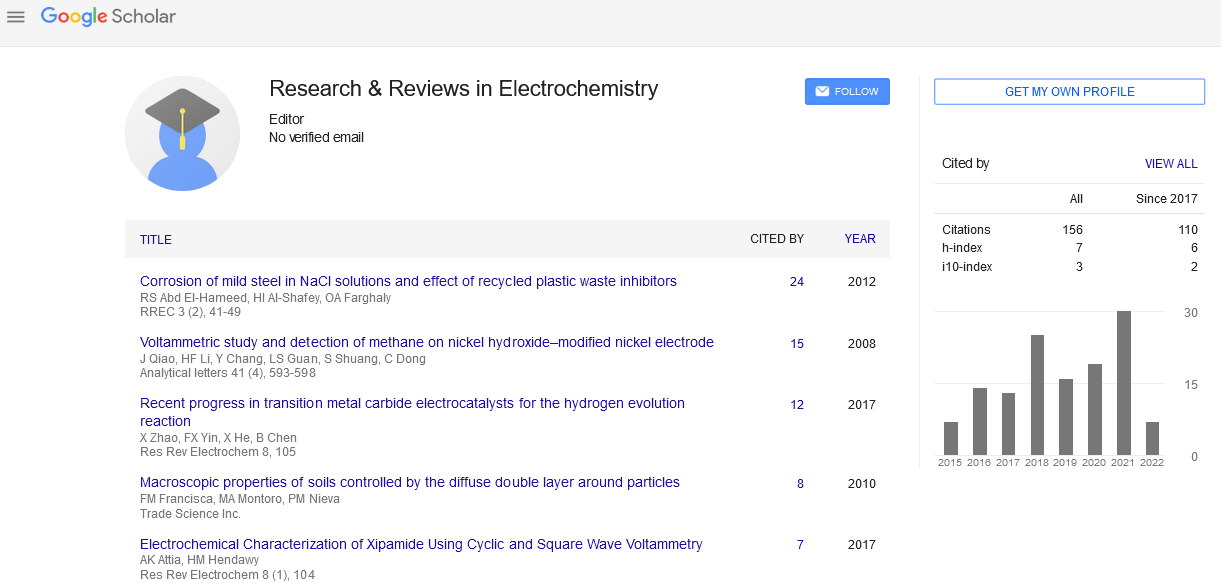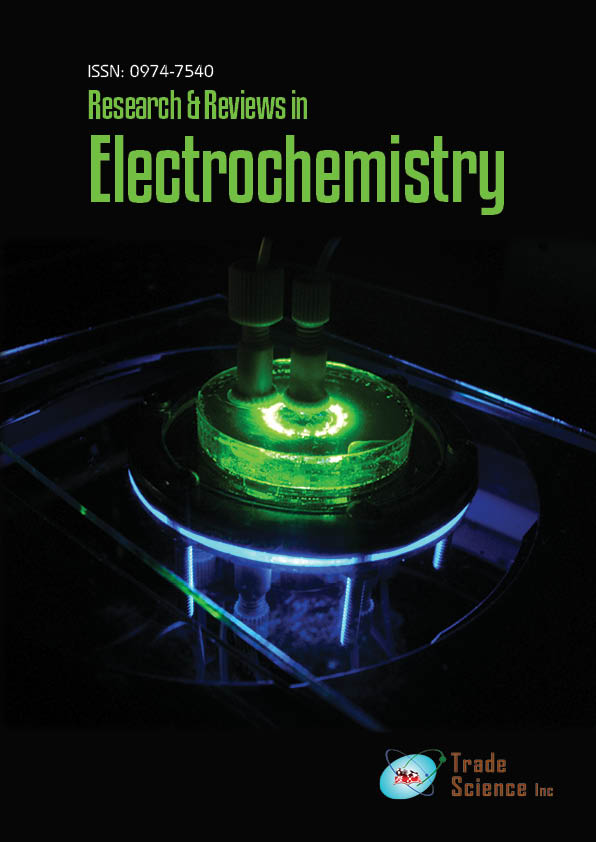Viewpoint
, Volume: 12( 2) DOI: 10.37532/0974-7540.22.12.2.240Rapid and Accurate Data Processing in Nano-Impact Electrochemistry for Silver Nanoparticle Oxidation
- *Correspondence:
- Robert StanEditorial Office, Research and Reviews in Electrochemistry, UK; E-mail: electro.med@scholarres.org
Received: 5-March-2022; Manuscript No. tsrre-22-66801; Editor Assigned: 18-March-2022; PreQC No. tsrre-22-66801 (PQ); Reviewed: 26- March-2022; QC No. tsrre-22-66801 (Q); Revised: 28-March-2022; Manuscript No. tsrre-22-66801 (R); Published: 30-March-2022, DOI No. 10.37532/0974-7540.22.12.2.240
Citation:Stan J. Rapid and Accurate Data Processing in Nano-Impact Electrochemistry for Silver Nanoparticle Oxidation. Res Rev Electrochem. 2022;12(2):240.
Abstract
Nano-Impact Electrochemistry (NIE) has gained extensive interest in recent years as a novel electroanalytical technique for the investigation and characterisation of single nanoparticles in solution. The proper analysis of the vast volume of experimental data is critical to improve the method's dependability. Unfortunately, the most generally utilised data analysis methods, which are mostly dependent on manual processing, are frequently time-consuming and subjective. In this paper, we offer a spike detection technique for automatically processing data from NIE experiments involving direct oxidation of silver nanoparticles (AgNPs), including baseline extraction, spike identification, and spike area integration. The obtained size distribution of AgNPs agrees extremely well with that from Transmission Electron Microscopy (TEM), indicating that the current approach is promising for automated NIE data processing with great efficiency and accuracy.
Keywords
Nanoparticles; Electroanalytica
Introduction
Nano-Impact Electrochemistry (NIE) is a key newly developed electroanalytical technology that allows for the investigation and characterisation of single nanoparticles in aqueous solution. Single nanoparticles, including but not limited to inorganic nanoparticles, organic nanoparticles, functional materials, and liposomes, can impact on the surface of a microelectrode stochastically via Brownian motion in this approach. The collision entities are expanded to include biospecies such as enzymes, cells, bacteria, and viruses. Electrochemical processes will occur during the impact of the single entities to the electrode, including direct electrolysis of the entities themselves, electrocatalytic reactions on the entities' surfaces, and diffusion blocking of the electroactive species by electrochemically inert entities.
The Compton Group presented direct electrolysis of nanoparticles in 2011, where single silver nanoparticles (AgNPs) were directly oxidised upon crashing to the surface of a carbon fibre microelectrode potentiostatted at an oxidative potential sufficient to oxidise silver. A spike in the current-time trace corresponded to a single oxidation event caused by AgNPs impact. Assuming that the AgNPs are totally oxidised, the size of single nanoparticles may be calculated using Faraday's Law by integrating the charge transmitted each spike. Anodic Particle Coulometry (APC) is an analytical approach that has been extended to the detection and characterisation of Au, Ni, and Cu nanoparticles. APC was also used to investigate the agglomeration of metal nanoparticles in aqueous solution and to quantify nanoparticle concentration. In comparison to traditional characterisation techniques like as electron microscopy and Dynamic Light Scattering (DLS), APC enables in-situ detection with ease, speed, and throughput. Metal nanoparticles can be utilised as electroactive probes for the detection of a wide range of biomolecules and bioentities, including proteins, bacteria, and viruses, due to their ease of engineering and functionalization. Because APC-based sensors can evaluate individual entities, they provide sensitive target analysis, exact bioentity counting, and a deeper knowledge of biological heterogeneity.
The measurement of the spikes on the current-time traces is the foundation of APC-based single entity analysis, whether it is a nanoparticle, a bacterium or a cell. As a result, precise detection and analysis of these spikes is critical to improve the method's dependability. Because of the vast amount of data and the relatively high background noise compared to the signals, frequently used data analysis software packages (such as Origin) that need manual data processing are not only time-consuming, but also add operator bias into the study. As a result, developing an automated approach for speedy and precise data processing of APC-based analysis is extremely desirable.
Synthesis and characterization of AgNPs
Citrate-capped AgNPs were produced using the seed-mediate growth technique, as described before. In a flask, 20 ml of 1% (w/v) citrate solution and 75 ml of water were combined and heated to 70°C for 15 minutes. The flask was then filled with 1.7 ml of 1 percent (w/v) AgNO3 solution, followed by 2 ml of freshly made 0.1% (w/v) NaBH4 solution. The mixture was heated at 70°C with vigorous stirring for 1 hour before being cooled to room temperature and diluted with water to 100 ml and used as starting seeds. After that, 2 mL of 1% citrate solution was added to 80 mL of water in another clean flask and heated until it boiled for 15 minutes. Following that, 10 ml of the starting seeds solution was added to the flask while vigorously stirring, followed by 1.7 ml of 1% AgNO3 solution. Before performing reflux condensation for 1 hour, the mixture in the flask was maintained boiling and stirring. Finally, it was allowed to cool to ambient temperature before being used. The morphology of AgNPs was studied using transmission electron microscopy on a copper film.
Nano-impact electrochemistry
The electrochemical measurements were carried out in a three-electrode cell within a double Faraday cage at room temperature. As a working electrode, a carbon fibre microelectrode with a diameter of 7m was employed. As a counter electrode and a reference electrode, a platinum wire and a Saturated Calomel Electrode (SCE) were utilised, respectively. The electrochemical measurements were carried out using a Metrohm-Autolab Autolab PGSTAT 302N equipped with an exceptionally low-noise (ECD) module to decrease background noise. The sampling rate was 435 Hz (2.3 ms), the current range was set to 0 pA to 100 pA, and the default bandwidth (below 100 Hz) was utilised in this case.

